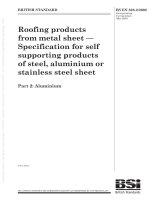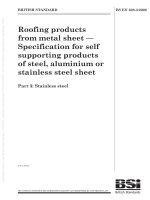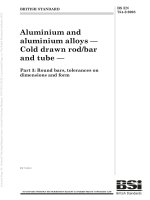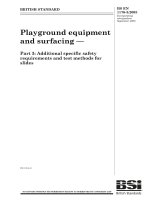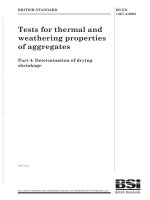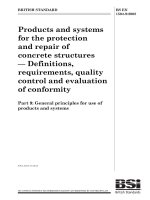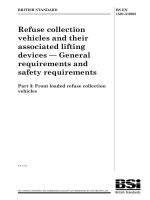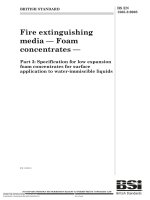Bsi bs en 01474 3 2008 (2009)
Bạn đang xem bản rút gọn của tài liệu. Xem và tải ngay bản đầy đủ của tài liệu tại đây (376.41 KB, 30 trang )
BRITISH STANDARD
Installation and
equipment for
liquefied natural gas
— Design and testing
of marine transfer
systems
Part 3: Offshore transfer systems
ICS 75.200
NO COPYING WITHOUT BSI PERMISSION EXCEPT AS PERMITTED BY COPYRIGHT LAW
BS EN
1474-3:2008
BS EN 1474-3:2008
National foreword
This British Standard is the UK implementation of EN 1474-3:2008.
The UK participation in its preparation was entrusted to Technical
Committee GSE/38, Installation and equipment for LNG.
A list of organizations represented on this committee can be obtained on
request to its secretary.
This publication does not purport to include all the necessary provisions
of a contract. Users are responsible for its correct application.
Compliance with a British Standard cannot confer immunity
from legal obligations.
This British Standard
was published under the
authority of the Standards
Policy and Strategy
Committee on 30 June 2009
Amendments/corrigenda issued since publication
Date
Comments
© BSI 2009
ISBN 978 0 580 57978 3
标准分享网 www.bzfxw.com 免费下载
BS EN 1474-3:2008
EUROPEAN STANDARD
EN 1474-3
NORME EUROPÉENNE
EUROPÄISCHE NORM
December 2008
ICS 75.200
English Version
Installation and equipment for liquefied natural gas - Design and
testing of marine transfer systems - Part 3: Offshore transfer
systems
Installations et équipements de gaz naturel liquéfié Conception et essais des systèmes de transfert marins Partie 3: Systèmes de transfert offshore
Anlagen und Ausrüstung für Flüssigerdgas - Auslegung und
Prüfung von Schiffsübergabesystemen - Teil 3: OffshoreÜbergabesysteme
This European Standard was approved by CEN on 1 November 2008.
CEN members are bound to comply with the CEN/CENELEC Internal Regulations which stipulate the conditions for giving this European
Standard the status of a national standard without any alteration. Up-to-date lists and bibliographical references concerning such national
standards may be obtained on application to the CEN Management Centre or to any CEN member.
This European Standard exists in three official versions (English, French, German). A version in any other language made by translation
under the responsibility of a CEN member into its own language and notified to the CEN Management Centre has the same status as the
official versions.
CEN members are the national standards bodies of Austria, Belgium, Bulgaria, Cyprus, Czech Republic, Denmark, Estonia, Finland,
France, Germany, Greece, Hungary, Iceland, Ireland, Italy, Latvia, Lithuania, Luxembourg, Malta, Netherlands, Norway, Poland, Portugal,
Romania, Slovakia, Slovenia, Spain, Sweden, Switzerland and United Kingdom.
EUROPEAN COMMITTEE FOR STANDARDIZATION
COMITÉ EUROPÉEN DE NORMALISATION
EUROPÄISCHES KOMITEE FÜR NORMUNG
Management Centre: rue de Stassart, 36
© 2008 CEN
All rights of exploitation in any form and by any means reserved
worldwide for CEN national Members.
B-1050 Brussels
Ref. No. EN 1474-3:2008: E
BS EN 1474-3:2008
EN 1474-3:2008 (E)
Contents
Page
Foreword..............................................................................................................................................................4
1
Scope ......................................................................................................................................................5
2
Normative references ............................................................................................................................5
3
Terms and definitions ...........................................................................................................................5
4
4.1
4.2
4.3
4.4
4.5
4.6
4.6.1
4.6.2
4.6.3
4.6.4
4.7
4.8
4.9
Definition and ability of the LNG transfer systems ............................................................................7
System requirement ..............................................................................................................................7
Overall safety philosophy .....................................................................................................................7
Overall functional targets and requirements ......................................................................................8
Design principles and risk assessment methodology.......................................................................8
Design principles ...................................................................................................................................9
Risk assessment..................................................................................................................................10
Hazard identification ...........................................................................................................................10
Risk analysis ........................................................................................................................................11
Risk assessment..................................................................................................................................11
Acceptance criteria..............................................................................................................................12
Safety-critical elements.......................................................................................................................12
Performance standards.......................................................................................................................12
Risk reduction ......................................................................................................................................12
5
5.1
5.2
5.3
5.4
5.5
5.6
New design qualification.....................................................................................................................13
Design qualification.............................................................................................................................13
Technology assessment .....................................................................................................................14
Risk assessment: failure mode identification ..................................................................................14
Analysis and testing ............................................................................................................................14
Reliability analysis...............................................................................................................................16
Compliance statements ......................................................................................................................16
6
6.1
6.2
6.3
6.4
6.5
6.6
6.7
6.8
6.9
6.10
6.11
6.12
Design basis and criteria of a LNG transfer system ........................................................................16
General..................................................................................................................................................16
Supporting structures and equipment ..............................................................................................17
Transfer line diameter and product data ...........................................................................................17
Dimensions and clearances ...............................................................................................................17
Stress analysis.....................................................................................................................................18
Dynamic behaviour (cyclic motions amplitude, speed and fatigue) ..............................................18
Special loads situations ......................................................................................................................18
Product swivel joints and structural bearings..................................................................................19
Connecting/disconnecting device .....................................................................................................19
Handling for connection, disconnection, storing.............................................................................19
Communications, evacuation and rescue.........................................................................................19
Others ...................................................................................................................................................20
7
7.1
7.2
7.3
7.4
7.5
7.6
7.7
Safety precautions...............................................................................................................................21
Introduction ..........................................................................................................................................21
Communication....................................................................................................................................21
Approach and control monitoring berthing and connection process ...........................................21
Position monitoring, alarm and shut down system for the LNG transfer systems ......................22
ERS system ..........................................................................................................................................22
Safety interfaces ..................................................................................................................................22
Control of fluid transfer.......................................................................................................................23
8
8.1
Connection with the LNGC .................................................................................................................23
Two main categories of LNG transfer systems are anticipated: ....................................................23
2
标准分享网 www.bzfxw.com 免费下载
BS EN 1474-3:2008
EN 1474-3:2008 (E)
8.2
8.3
8.4
Additional requirements for the ship shall address: .......................................................................23
In order maximise the level of standardisation the following guidance shall be observed: .......24
Systems and equipment for the position control of the LNG carrier during berthing,
connection and transfer: ....................................................................................................................24
9
Operating and control design ............................................................................................................24
10
Inspection and tests............................................................................................................................24
11
Quality assurance and control...........................................................................................................24
12
Documentation ....................................................................................................................................24
Annex A (normative) Procedure for deviation from the full standard .........................................................26
Bibliography......................................................................................................................................................27
3
BS EN 1474-3:2008
EN 1474-3:2008 (E)
Foreword
This document (EN 1474-3:2008) has been prepared by Technical Committee CEN/TC 282 “Installation and
equipment for LNG”, the secretariat of which is held by AFNOR.
This European Standard shall be given the status of a national standard, either by publication of an identical
text or by endorsement, at the latest by June 2009, and conflicting national standards shall be withdrawn at
the latest by June 2009.
Attention is drawn to the possibility that some of the elements of this document may be the subject of patent
rights. CEN [and/or CENELEC] shall not be held responsible for identifying any or all such patent rights.
This European Standard consists in 3 parts:
EN 1474-1: Installation and equipment for liquefied natural gas — Design and testing of marine transfer
systems — Part 1: Design and testing of transfer arms
EN 1474-2: Installation and equipment for liquefied natural gas — Design and testing of marine transfer
systems — Part 2: Design and testing of transfer hoses
EN 1474-3, Installation and equipment for liquefied natural gas — Design and testing of marine transfer
systems — Part 3: Offshore transfer systems
According to the CEN/CENELEC Internal Regulations, the national standards organizations of the following
countries are bound to implement this European Standard: Austria, Belgium, Bulgaria, Cyprus, Czech
Republic, Denmark, Estonia, Finland, France, Germany, Greece, Hungary, Iceland, Ireland, Italy, Latvia,
Lithuania, Luxembourg, Malta, Netherlands, Norway, Poland, Portugal, Romania, Slovakia, Slovenia, Spain,
Sweden, Switzerland and United Kingdom.
4
标准分享网 www.bzfxw.com 免费下载
BS EN 1474-3:2008
EN 1474-3:2008 (E)
1
Scope
This European Standard gives general guidelines for the design of liquefied natural gas (LNG) transfer
systems intended for use on offshore transfer facilities or on coastal weather exposed transfer facilities. The
transfer facilities considered may be between floating units, or between floating and fixed units. The specific
component details of the LNG transfer systems are not covered by this European Standard.
Reference is made to EN 1474-1 and EN 1474-2 where appropriate.
As a general statement the present standard applies to all transfer systems given in the scope. However,
some transfer system designs may require a deviation from the full standard as described in normative
Annex A.
2
Normative references
The following referenced documents are indispensable for the application of this document. For dated
references, only the edition cited applies. For undated references, the latest edition of the referenced
document (including any amendments) applies.
EN 1473, Installation and equipment for liquefied natural gas — Design of onshore installations
EN 1474-1:2008, Installation and equipment for liquefied natural gas — Part 1: Design and testing of transfer
arms
EN 1474-2:2008, Installation and equipment for liquefied natural gas — Part 2: Design and testing of transfer
hoses
EN 1532, Installation and equipment for liquefied natural gas — Ship to shore interface
EN 61511-1, Functional safety — Safety instrumented systems for the process industry sector —
Part 1: Framework, definitions, system, hardware and software requirements (IEC 61511-1:2003 +
corrigendum 2004)
EN 61511-2, Functional safety — Safety instrumented systems for the process industry sector —
Part 2: Guidelines for the application of IEC 61511-1 (IEC 61511-2:2003)
EN 61511-3, Functional safety — Safety instrumented systems for the process industry sector —
Part 3: Guidance for the determination of the required safety integrity levels (IEC 61511-3:2003 + corrigendum
2004)
EN ISO 9000, Quality management systems — Fundamentals and vocabulary (ISO 9000:2005)
EN ISO 9001, Quality management systems — Requirements (ISO 9001:2000)
3
Terms and definitions
For the purposes of this document, the following terms and definitions apply.
3.1
attitude
various modes of use and/or location of the transfer system (i.e. manoeuvring, stowed, connected, washing,
hydrostatic test and maintenance). The transfer system may take several positions for each attitude
NOTE
Transfer system see 3.18.
5
BS EN 1474-3:2008
EN 1474-3:2008 (E)
3.2
bank of transfer lines
all the transfer lines on the transfer system
NOTE
Transfer lines see 3.17.
3.3
cargo manifold (or manifold)
pipe assembly mounted on board LNG carrier to which the outboard flanges of the transfer system are
connected
3.4
coupler
manual or hydraulic mechanical device used to connect the transfer system to the LNG carrier’s manifold
NOTE
This device, when not employing a bolted connection, is often also referred to as QCDC i.e. quick
connect/disconnect coupler.
3.5
design pressure
pressure for which the transfer system is designed
3.6
design temperature
range of temperatures for which the transfer system is designed
3.7
emergency release coupling (ERC)
device to provide a means of quick release of the transfer system when such action is required only as an
emergency measure
3.8
emergency release system (ERS)
system that provides a positive means of quick release of transfer system and safe isolation of LNG carrier
and transfer system. An ERS normally contain one or several ERC’s
3.9
emergency shut down (ESD)
method that safely and effectively stops the transfer of LNG and vapour between the LNG carrier and the LNG
terminal
3.10
envelope, operating (or operating envelope)
volume in which the presentation flange(s) of a (group of) transfer line(s) is (are) required to operate
3.11
LNGC mooring
LNGC mooring arrangement on the terminal
NOTE
The possible mooring configuration includes: conventional mooring (jetty, quay, GBS/Gravity Base Structure,
…), Multi-Buoy Mooring/Conventional Buoy Mooring (MBM/CBM, …), side-by-side mooring of two floating units, tandem
mooring (single or double hawsers arrangement, “crowfoot” hawser arrangement, rigid or articulated yokes, …), DP
(Dynamic Positioning) or semi DP systems.
3.12
LNGC First Order Motions
heave, pitch, roll, surge, sway, yaw
NOTE
6
These motions apply as well for a floating LNG terminal.
标准分享网 www.bzfxw.com 免费下载
BS EN 1474-3:2008
EN 1474-3:2008 (E)
3.13
LNGC Second Order Motions
other motions of the LNGC when moored on the LNG terminal that have to be taken into account in the design
and operations like fishtailing, jack-knifing
NOTE
These motions results from the behaviour of the ship due to the mooring configuration. They apply in
combination with the LNGC motions in 3.12.
3.14
LNG terminal
LNG plant with liquefaction or re-gasification facilities
NOTE
The LNG transfer system is part of the LNG plant. The LNG terminal is supporting the transfer system that can
be onshore or offshore mounted on a fixed or floating structure with or without storage facility.
3.15
performance standard
statement, which can be expressed in qualitative or quantitative terms, of the performance required of a
system, item of equipment, person or procedure, and which is used as the basis for establishing the design
specification, manufacturing and installation for the safe operation through the life cycle of the installation
3.16
surge pressure
rapid change in pressure as a consequence of a change in flow rate in the transfer system
3.17
transfer line (or product line)
articulated piping, the transfer hose and swivels if any, or a combination of the piping and hose, allowing the
transfer of LNG and natural gas between the LNGC and the LNG terminal
3.18
transfer system
LNG and natural gas transfer system, the transfer system comprises the transfer lines and all their supporting
structure including the supporting structure on the LNG terminal, complete with all accessories,
control/detection systems, energy supply
NOTE
4
The transfer systems have typically mobile and fixed parts.
Definition and ability of the LNG transfer systems
4.1 System requirement
A description of the system and the operation shall be established.
Any system for offshore or coastal weather exposed operations, including LNG-C mooring and transfer
systems, has to be considered as new development, should it incorporate arms or hoses. Development of
specific performance standards for compliance would be required. These performance standards would be
developed based on risk assessment techniques (see Clause 5).
4.2 Overall safety philosophy
An overall safety philosophy shall be established and documented by the owner, reflecting applicable
legislation, owner requirements, industry standards and best practices. The overall safety philosophy shall
address the risk categorisation and also acceptance criteria. It shall be complemented as necessary, prior to
commissioning, with vendor specific recommendation concerning precautions for use of the systems or parts
of it. It shall be consistent with the terminal general safety philosophy.
7
BS EN 1474-3:2008
EN 1474-3:2008 (E)
4.3 Overall functional targets and requirements
The overall functional requirements for the cargo transfer system shall be identified and documented. As a
minimum the following capabilities shall be addressed for the different operational phases:
berthing configuration (tandem or side by side or single point mooring, …);
additional requirements to the manifold on the LNG carrier when required (e.g. tandem or single point
mooring offloading);
berthing and mooring procedure;
procedure for connection, transfer and disconnect including emergency release;
process of monitoring and management of continual relative movements between vessels (CPMS,
telemetry etc.);
procedure and facilities handling, lifting and storing of transfer equipment;
transfer capacities for LNG and vapour return (volume flow, pressure, temperature);
availability requirements;
requirements for the ESD system (sequence, timing, process responses);
regulatory requirements;
requirements related to local regulations, flag if any;
owner QA requirements, such as classification, certification requirements.
4.4 Design principles and risk assessment methodology
A risk assessment shall be conducted as part of the overall assessment of the LNG transfer system. In
general for the overall system assessment the following objectives would apply:
evaluation of the design and operational procedures;
determination of the limiting conditions for the offloading operations;
assessment of safety and operability via risk assessment techniques;
determination of regulatory compliance (certification, classification): this section describes the design
principles and the approach to establish design requirements for the transfer system.
Risks shall be assessed in accordance with recognized methods and risk studies shall be performed by
qualified and competent persons with the necessary understanding of risk, and the risk assessment process.
The risk assessment methodology and tools, assumptions, and system boundary limits shall be clearly
documented.
A risk based approach shall be used to ensure that:
critical elements and operations are identified;
performance standards are defined when applicable;
controls and mitigating measures are identified;
8
标准分享网 www.bzfxw.com 免费下载
BS EN 1474-3:2008
EN 1474-3:2008 (E)
aspects of new technology, as defined below, are identified and qualified according to requirements in
Clause 5.
In this context, new technology is defined as technology that is not proven. Proven technology has a
documented track record for a defined application. Information guidance can be found in the Bibliography.
The identification of new technology should be done by dividing the technology into manageable elements and
classifying the technology elements with respect to newness according to Table 1 considering the status of
the technology as such, and its application area.
Table 1 — Example for classifying the technology elements
Application area
Technology status
Proven
Limited field
history
New or unproven
Known
1
2
3
New
2
3
4
This classification implies the following:
1)
no new technical uncertainties;
2)
new technical uncertainties;
3)
new technical challenges;
4)
demanding new technical challenges.
This classification applies to the totality of the applied technology as well as each separate part, function and
subsystem forming it. It shall be used to highlight where care needs to be taken due to limited field history.
Technology in Class 1 is proven technology where proven methods for qualification, tests, calculations and
analysis can be used to document margins. Technology defined as Class 2 to 4 is defined as new technology,
and shall be qualified according to Clause 5. The distinguishing between 2, 3 and 4 makes it possible to focus
on the areas of concern.
4.5 Design principles
The following principles shall apply in addition to the identified requirements from a risk assessment:
General
1)
Transfer system shall be designed, constructed and maintained with sufficient integrity to withstand
operational and environmental loading throughout the system lifecycle, refer to Clause 6).
2)
Systems and structures shall be designed with suitable functionality and survivability for prevention,
detection, control and mitigation of foreseeable accident events affecting the installation.
3)
Systems and structures shall be designed in compliance with internationally accepted codes and
standards.
4)
Where novel transfer solutions (new technology or novel application of known technology) are
intended to be used, this technology is to undergo a recognized qualification procedure. Refer to
Clause 5.
9
BS EN 1474-3:2008
EN 1474-3:2008 (E)
Specific safety issues
1)
Escalation of accidental event to LNG Terminal or LNG carrier which are not affected by the initiating
event shall be avoided/mitigated.
2)
Effective protection and escape shall be provided to safeguard all personnel.
4.6 Risk assessment
4.6.1
Hazard identification
Hazards with the potential to threaten safety of personnel or integrity of the installation shall be identified. The
hazard identification should include all normal operating and emergency operations, such as operation,
maintenance, shutdown, emergency disconnection and identify hazards according to the risk categories
derived from the functional requirements and safety philosophy.
Typical hazard identification techniques include e.g. HAZOPs, FMEA, safety reviews etc.
Risk categories shall as a minimum include risk to personnel, environmental releases, and damage to the
installation or the LNG carrier. Risks related to loss of production, downtime and reputation may be included.
A typical, but not necessarily exhaustive, list of hazards includes:
loss of containment, leading to hydrocarbon releases with potential to result in fires or explosions;
collisions (e.g. damage to LNG carrier, terminal and transfer system);
damage due to cryogenic leakage on surfaces (e.g. embrittlement) and at sea (e.g. risk of rapid transition
phase);
helicopter crash;
structural and or foundation failure;
loss of stability and buoyancy;
dropped objects;
mooring, and station keeping of approaching vessel during connection, transfer and disconnect;
extreme weather causing excessive relative motions between the installations;
failure in supporting systems (power, hydraulics, monitoring).
The hazard identification process shall address and focus on the specific issues for cargo transfer systems
including:
side by side offloading;
tandem offloading;
single point Mooring offloading;
other offloading systems;
mooring configurations for the above;
10
标准分享网 www.bzfxw.com 免费下载
BS EN 1474-3:2008
EN 1474-3:2008 (E)
transfer lines related failures;
connect/disconnect and flanged connections failures;
constant position monitoring systems (CPMS) and operations;
emergency release systems (ERS);
safe isolation and inerting operations;
issues related to cargo tank overpressurization (and other containment system issues) during offloading;
load bearing structures;
containment systems for process fluids;
actual weather limitations for operation;
anticipated weather change.
The results of the hazard identification and any relevant assumptions shall be documented (see 5.2).
4.6.2
Risk analysis
Hazard assessment shall be performed according to the method described in EN 1473.
The identified hazards can be ranked based on combination of likely frequency and consequence.
Insignificant risks may be eliminated from further evaluation provided that relevant assumptions are
documented.
Risks shall not be subdivided such that individual risk elements appear trivial, whereas collectively still
represent a substantial risk.
Consideration of frequency includes identification of initiating events, and combinations of events, which could
lead to a hazard. The likelihood of occurrence of such events can be found from historical or other appropriate
data.
The consequences of the hazards shall include analysis of the effects of accidents or accidental events on the
safety of personnel and integrity of the installation.
The availability and vulnerability of key prevention and protection systems shall be assessed with respect to
required functionality against each of the identified hazards. Any significant findings shall be consistent with
assumptions made in other parts of the risk analysis and assessment.
The hazards remaining after the screening exercise are termed significant major hazards. The selection of
significant major hazards, including assumptions made as part of the ranking process, shall be documented.
NOTE
A semi-quantitative or a qualitative approach is recommended for the ranking of risk when s relevant failure
data required for a quantitative assessment is not available for novel applications tools such as HAZOPs, fault trees and
engineering judgement may be effectively applied to screen out hazards that are trivial or of minor significance. This
includes hazards and escalations which are extremely unlikely to occur (e.g. due to the effectiveness of prevention
measures in place), or which will have minor consequence to personnel or property.
4.6.3
Risk assessment
The risks from significant major hazards shall be assessed and considered together in order to show the
relative contribution of different hazards to the total calculated risks.
11
BS EN 1474-3:2008
EN 1474-3:2008 (E)
The annual risks shall be assessed against predefined risk acceptance criteria. If necessary, risk reduction
measures shall be applied in order to meet the acceptance criteria.
4.6.4
Acceptance criteria
Acceptance criteria shall be defined before performing the risk analysis.
It is the owner responsibility to ensure that the acceptance criteria reflecting the functional requirements and
overall safety philosophy are in line with regulatory requirements and best practices (refer to 4.2 and 4.3).
The criteria shall take into account both the probability and consequences of significant major hazards.
Meeting the acceptance criteria will establish the basis for identification of safety-critical elements and
selection of performance standards.
4.7 Safety-critical elements
Once the acceptance criteria have been defined, the safety-critical elements and performance standards shall
be recorded.
Safety critical elements are those components or systems that their failure could cause or contribute
substantially to the reduction of the LNG transfer safety and integrity; or those that their purpose is to prevent
or mitigate from the effect of hazards which threaten such safety and integrity.
Safety-critical elements should be identified from, and shall be fully consistent with, the major hazard
scenarios considered in the assessment. Identification of elements should also include input from good
engineering judgement. The selection of items as safety-critical shall be based on consequence of failure.
NOTE
The safety critical elements should typically include alarms (multi stage) ERS, ESD, blow down, pressure relief
venting and drainage, fire protection, station keeping and position monitoring.
4.8 Performance standards
Specific performance standards (see term and definition 3.15 in Clause 3) shall be established for the safetycritical elements, eventually complementing design criteria mentioned in following chapters. The performance
standards shall be such that the safety-critical elements are suitable for fulfilment of the risk acceptance
criteria as demonstrated in the assessment. The performance standards shall be suitably described, normally
in quantified terms, so as to be verifiable for the safety-critical elements.
The performance standards shall reflect any relevant lifecycle requirements of the critical element.
The performance standard shall also reflect any interaction or dependence between safety-critical elements
for a particular major accident scenario.
4.9 Risk reduction
The results of hazard identification and analysis present a good opportunity for targeted risk reduction. Hazard
identification and evaluation is most effectively initiated at concept design stage where risks can be avoided or
reduced.
Risk reduction shall be based on ALARP principle (As Low As Reasonable Practicable).
NOTE
12
Identified hazards should be avoided/mitigated through e.g.:
removal of the source of a hazard (without introducing new sources of hazard);
breaking the sequence of events leading to realisation of a hazard.
标准分享网 www.bzfxw.com 免费下载
BS EN 1474-3:2008
EN 1474-3:2008 (E)
Where hazards cannot be avoided, design and operation should reduce the likelihood of hazards occurring,
e.g. by:
reduction in number of leak sources (flanges, instruments, valves etc.);
removal or relocation of ignition sources;
simplifying operations, avoiding complex procedures and inter-relationships between systems;
selection of better materials;
mechanical integrity/protection;
reducing the probability of external initiating events, e.g. lifting operations;
reduction in inventory, pressure, temperature;
use of less hazardous materials, process or technology.
The consequences of hazards should be controlled and mitigated to reduce risk to personnel, property and
environment e.g. through:
5
relocation of equipment, improved layout;
provision of physical barriers, separation distances, fire walls etc.;
provision of detection and protection systems;
provision of means to escape and evacuate.
New design qualification
5.1 Design qualification
The new transfer system design shall satisfy:
equivalent levels of safety with conventional ship to shore LNG transfer systems;
owner’s specified level of reliability and availability;
acceptance criteria resulting from the application of Clause 4.
The key issues of the qualification strategy are as follows:
assessment of suitability for purpose of the system’s design, structure, and equipment against
established performance standards;
methodology for the identification of the system’s critical elements consistent with the risk assessment
methodology;
criteria of risk ranking linked to the elements safety criticality;
scheme verification throughout the lifecycle of the system (certification/classification) enabling future
modifications to be reviewed and verified.
13
BS EN 1474-3:2008
EN 1474-3:2008 (E)
5.2 Technology assessment
Transfer systems will normally comprise combination of known and novel technology. The proposed solution
shall be assessed with the aim to identify the novel elements and novel application of known technology to
focus the qualification programme on these.
The qualification programme shall demonstrate safety and integrity to a level equivalent to conventional
systems. Compliance of design and operational safety to accepted codes and standards should be verified by
risk assessment techniques (see Clause 4) and recognised qualification procedures (see Bibliography).
5.3 Risk assessment: failure mode identification
The failure mode identification shall provide a consistent approach with the risk assessment methodology (see
Clause 4).
This shall be followed by a more systematic examination of failure modes and shall cover:
abnormal modes of operation;
possible causes of failure;
method of failure detection;
consequences of failure;
possible corrective mechanisms.
The purpose of the evaluation shall be to establish that any system will provide an equivalent level of integrity
with the arrangements addressed in the prescriptive codes. Also to identify areas which may not be covered
by the codes as these will be required to achieve the functional requirements as defined in 4.3 and safety
performance standards established according to 4.8.
From the above methodology a list of critical elements relating to the LNG transfer system offshore shall be
established. Also at this stage categories of criticality can be defined using primarily qualitative risk based
evaluation criteria.
5.4 Analysis and testing
For the adoption of a transfer system the following general issues should be considered:
compliance with the requirements of EN 1474-1 and EN 1474-2 (where applicable);
application of proven systems and components;
ability to monitor and manage relative movements between the two vessels and the velocity of drift of the
shuttle tanker;
reliability of control equipment (such as logic control systems and hydraulic drive systems);
reliability of connecting / disconnecting systems and components;
emergency release system;
optimum access to all system parts for inspection and maintenance.
Structural analysis shall be carried out with focus on new technology elements and areas identified in the
risk assessment (general requirements to structural analysis are given in Clause 6). The objective of the
14
标准分享网 www.bzfxw.com 免费下载
BS EN 1474-3:2008
EN 1474-3:2008 (E)
structural analysis shall be to assess the global and local structural performances of all components and
check adequacy to relevant criteria. Structural strength shall be evaluated considering all relevant,
realistic loading conditions and combinations with particular attention given to the design of critical
interfaces.
Design calculations should take into account the following aspects:
strength;
fatigue;
corrosion;
survival conditions intact and damage (ship to ship mooring line failure);
operating maximum loading conditions;
accidental loading;
motions and loads spectra.
Basin and/or model testing should generally be necessary to validate a marine LNG transfer system. It
can be too complex in a dynamic environment to be reliably analysed by numerical methods alone. It
therefore forms an essential stage in the design process and should be capable of providing loads and
motions for all vital components.
The risk assessments previously established in 4.6 shall require that:
sufficient qualification destructive testing is carried out, in order to conservatively validate the prediction
methodology;
sufficient proof or acceptance non-destructive testing is carried out satisfactorily.
It shall identify all failure modes and accurately and reliably predict the corresponding limit states, and
subsequently ensure sufficient safety and availability through the service life of the system.
Where new limit states exceed currently proposed design, further destructive testing may be required to
further qualify the system.
Some installations may need project-specific model and / or basin testing with supporting dynamic analysis
carried out to establish the transfer system and mooring configuration and vessels responses.
While the results of the risk assessment should clarify the relevance for each component concerned,
qualification testing should address the following:
burst;
leak;
spillage;
creep;
cryogenic brittleness;
limit states under combination of pressure and external forces when applicable;
15
BS EN 1474-3:2008
EN 1474-3:2008 (E)
fatigue;
ageing;
operability in cryogenic conditions.
Tests shall be sufficiently instrumented to assess the accuracy in the elastic range (and/or of non-linear
material properties if applicable) of stress/strain prediction through calculation, to verify conservatism, and
subsequently validate the safety margins provided in design. The effect of fabrication tolerances is to be
sufficiently investigated in the process.
Similarly, temperature gradients prediction methodology and their effects shall be validated as necessary.
The specification for the testing programme shall include tests and measurements, which allow calibration of
the numerical analysis tools accounting for the LNG carrier’s dynamic behaviour in regular and irregular
waves.
The programme of model tests should include a suitable number of load cases adequately covering all the
critical situations in which each component of the transfer system experiences a maximum load or motion.
5.5 Reliability analysis
Reliability and availability studies shall be carried out and shall involve a detailed examination of the critical
systems, in order to highlight the criticality of the LNG transfer system or elements within the system.
The objective of reliability analysis is to confirm that functional requirements as stated in 4.3 and safety
performance standards according to 4.8 are fulfilled. Reliability and availability studies shall involve a detailed
examination of the system and as far as possible be quantitative, i.e. based on a statistical assessment of
collected data.
5.6 Compliance statements
The following statements of compliance shall be issued as part of the system’s qualification process:
Statement of feasibility, concept approval certificate.
A statement issued by a class society, certification/verification body or other approved independent. Third
party which based on the results of a concept design evaluation/high level risk assessment or equivalent,
would establish that the system can be approved in principle.
Statement of fitness for service, type approval certificate, certification/verification report.
A certificate of fitness, class notation or other equivalent document which is issued following appraisal of all
relevant plans and supporting documentation together with on-site survey during construction and
installation/commissioning and confirms that the performance requirements, codes, rules and regulations have
been met.
6
Design basis and criteria of a LNG transfer system
6.1 General
A risk assessment study shall be performed (see Clause 4).
Calculations shall be performed to assess the design conditions (and complemented if necessary by model
tests refer to 5.4).
16
标准分享网 www.bzfxw.com 免费下载
BS EN 1474-3:2008
EN 1474-3:2008 (E)
The design shall reflect applicable legislation – international and local, owner requirements, industry standards
and best practices.
Design conditions and parameters are to consider the maximum allowable significant wave heights and
specific metocean conditions, beyond which any transfer of the cryogenic product is to be stopped.
The transfer system in stowed position shall be designed for the same return period of the metocean data as
the terminal. For winds, the 3 s gust shall be considered.
Any requirements on the design metocean conditions during transfer system moving (from storage to
connecting position or reverse) shall be specified by the owner.
The local environmental conditions (temperatures ranges (sea and air), humidity levels, salt mist, possible
inclinations, vibrations etc.) shall be clearly defined to allow for the selection of materials and equipment.
6.2 Supporting structures and equipment
Any fixed, floating or ancillary structures, material and equipment used to support, lift or move LNG transfer
systems, should be designed, constructed and tested to meet the requirements of the existing applicable
codes, and international and national standards.
The supporting structures shall be designed for all operational and survival metocean loads as specified in
existing applicable codes and shall incorporate all loadings resulting from the LNG transfer system operation.
These structures identified to be critical (see 4.6) shall also be designed for accidental loadings. All
operational and accidental conditions to be identified as recommended in Clause 4.
Equipment and lifting devices belonging to the LNG transfer system shall be designed for the loading as
specified in applicable international offshore codes and national standards.
All other fixed or floating structures and equipment shall be designed, constructed and tested in accordance
with applicable international and national codes and standards.
Accessories (nitrogen injection line, storage locking device, ladders and platforms, liquid nitrogen line, thermal
insulation) shall be designed according to EN 1474-1:2008, 4.5 or EN 1474-2:2008, Clause 5 as appropriate
otherwise in accordance with applicable international and national codes and standards.
6.3 Transfer line diameter and product data
The LNG transfer line should be sized according to EN 1474-1:2008, 4.2.1 and/or EN 1474-2:2008, Clause 5.
Pressure loss curve for LNG and vapour return within the transfer system shall be agreed between the vendor
and the owner.
The product characteristics shall be specified by the owner.
6.4 Dimensions and clearances
Transfer system dimensions
The vendor shall ensure that the transfer system satisfies all specified requirements.
Clearance and clash study
The design shall cater for the minimum clearances defined by the owner for the different attitudes of the
transfer system.
17
BS EN 1474-3:2008
EN 1474-3:2008 (E)
The specified recommended minimum clearances are operating requirements i.e. after any deflections and
fabrication and erection tolerances. The location of main clearance checkpoints shall be defined. Vendor’s
clearance study shall be based on a drawing of the LNG terminal layout in elevation and plan including any
expansion for future transfer systems.
The transfer system vendor has the responsibility to identify all check points where there is the potential for
interference of all transfer systems (including future).
Risk of geometrical interferences and potential clash between the transfer system and LNGC or terminal
should be avoided during connection, normal operations, normal and emergency disconnection operations.
Minimum distances between the terminal and the tanker shall be clearly specified and all required means to
make the transfer reliable are to be provided.
6.5 Stress analysis
Stress analysis of pressure containing and non-pressure containing components shall satisfy the applicable
requirements of EN 1474-1:2008, 4.2.2.2. Flexible hoses components shall satisfy applicable requirements of
EN 1474-2:2008, Clause 5.
LNG terminals constructed in areas which are considered seismically active, seismic loads from appropriate
floor spectra shall be considered for the structure, the foundations and the offloading system.
Site investigations and analytical modelling are to be carried out to evaluate the nature, magnitude and return
intervals of potential seafloor movements.
For floating types terminals the dynamics loads due to terminal motions shall be considered.
If applicable, green seas loads shall be considered as well as ice loads in cold environment.
Accidental (survival) loads shall be considered for the design of safety critical equipment.
6.6 Dynamic behaviour (cyclic motions amplitude, speed and fatigue)
Dynamic behaviour of transfer system due to the relative displacements of the LNG carrier and the LNG
terminal in the design conditions, as well as (due) to direct environmental load effects on the exposed transfer
system shall be assessed.
Resulting cyclic and maximum loads shall be taken into account for the stress analysis and fatigue analysis of
load bearing components including structural connection with the terminal and the LNG carrier manifolds.
Fatigue response of engineering materials to various loads that might occur throughout the design life of the
structural components of the transfer system shall be taken into account.
Effects of various loading spectra and associated stress spectra, which will in general be a function of the
design configuration and the operational conditions of the loading/unloading system, shall be taken into
account. This can be done by adopting a linear cumulative damage theory for the purposes of assessing
fatigue damage.
Static loadings from weight and fluids pressure effects shall be combined if relevant, should a mean stress
have an influence on fatigue life.
6.7 Special loads situations
Balancing conditions of the mobile assembly part of the transfer system, with or without ice build-up, shall be
taken into consideration.
18
标准分享网 www.bzfxw.com 免费下载
